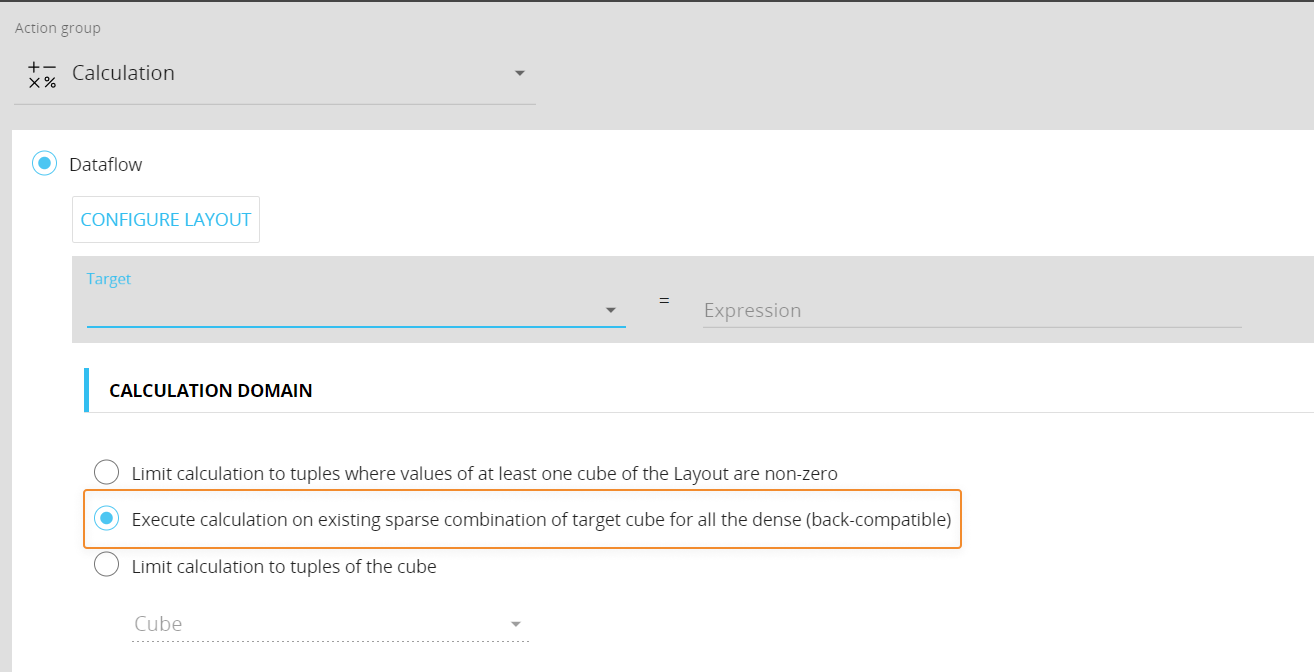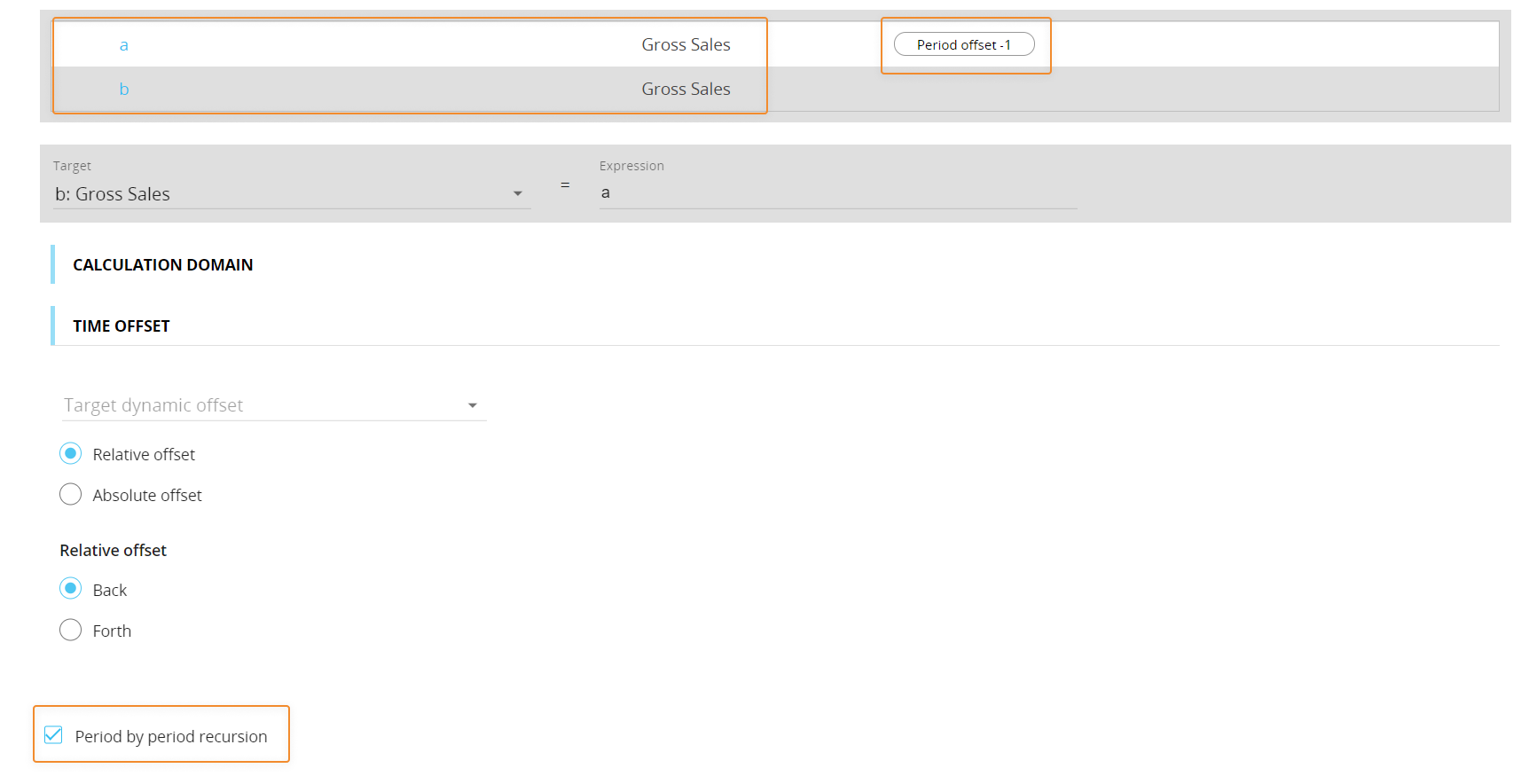Dataflow
The Dataflow has been greatly improved in terms of performance optimization and bug fixing. The Dataflow in Board 2021 Spring release is dramatically faster than Dataflows in previous versions.
Dataflow calculations are now executed only on the non-null cells of the DataFlow Layout by default. The Dataflow will process the formula for each combination of members of Entities that are in the target cube structure. The process won't be carried out for every potential combination, but only for those that have a non-zero value on at least one of the Dataflow blocks: each combination is called a tuple.
It is possible to extend or reduce the range of processed tuples through the Calculation Domain setting.
The domain can be limited or expanded as follows:
- It can be limited to tuples that hold non-zero values in every block
- It can be limited to tuples that hold non-zero values in a chosen cube in the Data model
- It can be expanded evaluating also the combinations that hold zero values in the Layout configuration for all members of a given set of Entities of the target cube.
The Calculation Domain setting allows to explicitly define the range of cube cells that will be processed, therefore simplifying the definition of Dataflow regardless of cubes structures and at the same time optimizing performance by processing only the desired cube part.
Limit calculation to tuples where values of at least one cube of the layout is non-zero
This is the default behavior of the Dataflow in Board 2021 Spring release.
When this option is active, Dataflows will calculate all non-zero combinations in at least one of the data blocks affected by the dataflow, ignoring the density/sparsity of the target Cube.
When upgrading from Board 10.x, every Dataflow configured in your previous version will be set with this option as active: we recommend setting domain options if existing Dataflows provide different results after the upgrade.
The Dataflow in Board 10.x wrote data only on existing combinations in sparse structures and for each dense combination of entities included in the target cube structure.
A new domain option for Dataflows has been introduced: "Execute calculation on existing sparse combination of target cube for all the dense (back-compatible)".

The new option will automatically set the domain to what it was in version 10.x: this is particularly useful in case of upgrades from version 10.x, since Dataflows will be using the same behaviour of cell-based Dataflows in versions 10.x.
If used with HBMP Dataflows, this option can have a negative impact on performance.
The Dataflow now writes data on each existing combination in at least one of the cubes involved in the process and for each combination of entities indicated in the extend section domain.
It is also possible to write data only on existing combinations of a given cube using the limit option. The limit option can be combined with the extend options, so the Dataflow process will be performed on existing combinations in the cube set in the limit option and for each combination of extend entities in a Select.
New Period by Period recursion flag on Dataflows
If the target Cube of a Dataflow is also a source for that same Dataflow and the source block is set to period offset negative, a new option can be selected.
The new option can only be selected if all the previously mentioned requirements are met.
The new “Period by Period recursion” checkbox allows to use the result of the calculation on the first period as the source for the calculation on the next period.

This option is particularly useful for those calculations where the result of the Dataflow for the first period needs to be used as the source for the following one.
The new Period by Period recursion is also referenced in the Impact Analysis section of the Data model affected by the Dataflow calculations:
- Recursion Active. The option is active
- Recursion Available. The option can be selected (but it might be inactive)

Double lift down extended also to triple and more
Board 2021 Spring release makes it easier to move data from two or more parent Entities to a leaf Entity with a Dataflow.
Board 10.x and Board 11.x allowed, in some cases, to perform a double lift allocation: Board 12 support all possible cases for this type of Dataflow, including multiple allocation.

Main points to keep in mind
- If you're upgrading from Board 11.3 to Board 12, Dataflows will work the same way. Simply remove any unnecessary extension options.
- If you're upgrading from Board 10, remember that the default domain for cell-based Dataflows is different so you might want to update it with extend and limit options or use the back-compatible option to make the Dataflow running the same as before
- Join Dataflows are still supported, but Dataflows with extend are way more performing
- Target dynamic offset is supported in Board 2021 Spring release but not in Board 11.x